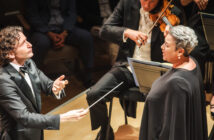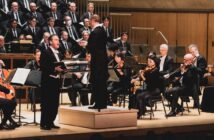
Roberto Sierra (photo: above) was born in Puerto Rico and studied with György Ligeti in Germany. Since 1992 he has been a member of the faculty of music at Cornell University, and is widely recognized as one of the leading composers of his generation.
Sierra’s Missa Latina “Pro Pace” (For Peace) was commissioned by Washington’s National Symphony and the Choral Arts Society, and Leonard Slatkin conducted the premiere with those combined ensembles in 2006. Since that time the work has been performed in major cities around the United States, each time with great success. Craig Hella Johnson (photo: right) and Conspirare brought the “Missa Latina” to Texas last month with performances in Victoria and in Austin, where I heard it.
Craig Hella Johnson (photo: right) and Conspirare brought the “Missa Latina” to Texas last month with performances in Victoria and in Austin, where I heard it.
Some years ago composer Osvaldo Golijov had a major triumph with his Pasión según San Marco (2000), which combined elements of the Christian liturgy with folkloric elements from the music of Latin America. Sierra attempts a similar cross-fertilization but in a more conservative, less theatrical way. Both works are valuable additions to the modern repertoire of Christian liturgical music.
Sierra clearly sets himself in the great tradition of symphonic masses; that is to say, compositions by the great composers which reach beyond the confines of church services. J.S. Bach was one of the originators of this tradition with his B minor Mass and then came Haydn, Beethoven, and Bruckner.
In the twentieth century Leonard Bernstein took a radical, popularizing approach to the challenge of writing a mass and produced a work that is still controversial. Although Sierra didn’t use Bernstein as a model he introduced “pop” elements from his own Caribbean culture. He also emulated Bernstein in wanting to convey a social message through his music. Sierra, who has often said that he is troubled by the “constant state of war” in our modern world, added a plea for peace to his Latin mass.
The Missa Latina begins with an ‘Introitus,’ the opening words of which are “Da pacem, Domine” (Give peace, O Lord). This ‘Introitus,’ which is slow-moving, quiet and dominated by the soprano soloist, also has a languid peacefulness that reminded me of several of Canteloube’s Songs of the Auvergne, but then the ‘Kyrie’ bursts forth and we are in the midst of an angry world very much in need of peace. The ‘Gloria’ follows, providing relief with dance rhythms and major key brightness abounding. The ‘Credo’ is again dark and disturbing. It is here that we are reminded of the coming of Jesus and his crucifixion.
The ‘Sanctus’ contains the most joyous music in the Missa Latina and listeners may well have trouble resisting the urge to get up and dance. The work ends with an ‘Agnus Dei’ and another plea for peace. The soprano solo is dominant in this movement with soaring, quasi-improvisatory melodic patterns. Sierra ends the work on a positive note, repeating the rhythmically infectious Alleluia from the ‘Offertorium.’
In spite of its use of popular Latin dance rhythms, the Missa Latina is a deeply serious and complex work. The harmonies are often abrasively chromatic and the contrapuntal choral writing occasionally academic.
One of the weaknesses of the piece may be that it is so relentlessly thick in texture. The Missa Latina might have benefitted greatly from the addition of several purely orchestral episodes, and a more frequent use of solos in the orchestra; for the most part, the upper strings in the orchestra couldn’t be heard at all through the obscuring weight of the wind and brass – even in quiet passages. This imbalance is not the fault of the conductor; it is simply poor orchestration. As with so many things in art and life, less is often more. The same principle applies to the vocal solos. Soprano Heidi Grant Murphy (photo: right), who was featured in the premiere performance and in many subsequent ones, sang magnificently on this occasion, with a lovely range of colors and total command of phrasing. Sierra, however, went too far in his demands on the soprano voice. Murphy began to show signs of strain near the end of her performance, by which time some audience members were clearly beginning to tire of the seemingly endless soprano solos in this piece.
The same principle applies to the vocal solos. Soprano Heidi Grant Murphy (photo: right), who was featured in the premiere performance and in many subsequent ones, sang magnificently on this occasion, with a lovely range of colors and total command of phrasing. Sierra, however, went too far in his demands on the soprano voice. Murphy began to show signs of strain near the end of her performance, by which time some audience members were clearly beginning to tire of the seemingly endless soprano solos in this piece.
Happily, Ms. Murphy had no trouble projecting over the choral and orchestral forces. Baritone Daniel Teadt, on the other hand, was too often simply overwhelmed.
The Conspirare Symphonic Choir and the Conspirare Company of Voices were joined by the Texas State University Chorale and the Victoria Bach Festival Orchestra and Chorus, under the direction of conductor Craig Hella Johnson. As is the case with most productions organized by Johnson and Conspirare, the musical standard was extraordinarily high.
Judging by the enthusiastic response at the Austin performance, the audience loved the Missa Latina. True, they were applauding the performers, most of whom are known and respected locally, but surely they were also expressing their appreciation for a work which challenged them and enriched their lives. As does Beethoven’s Missa Solemnis, a work many listeners still find “difficult” to understand, Sierra’s Missa Latina packs an emotional and dramatic punch that is almost irresistible.
For Those Wanting More…
The Missa Latina was recorded in 2008 by the Milwaukee Symphony Orchestra and Chorus conducted by Andreas Delfs with Heidi Grant Murphy, soprano, and Nathaniel Webster, baritone (Naxos 8.559624). Much of Roberto Sierra’s vast compositional output has been recorded. For a complete list and more information about the composer visit his website.
For the record, this was not the Texas premiere of Sierra’s Missa Latina; that honour goes to the Houston Symphony and Chorus, led by Leonard Slatkin (May, 2009) with – yes, Heidi Grant Murphy as the soprano soloist!
Paul E. Robinson is the author of Herbert von Karajan: the Maestro as Superstar,and Sir Georg Solti: His Life and Music. NEW for friends: The Art of the Conductor podcast, “Classical Airs.”
Photo of Roberto Sierra (above): Ellen Zaslaw
Sierra’s “Missa Latina” Wins New Friends in Texas
0
Share:














